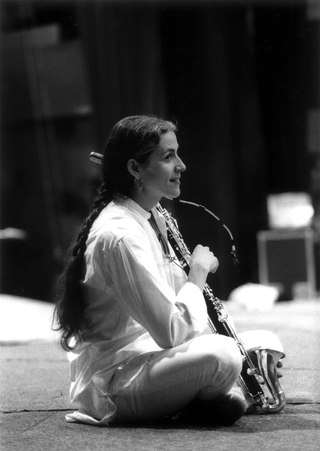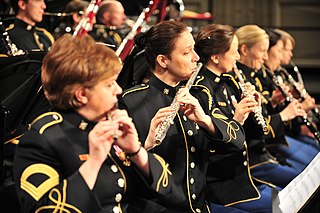The clarinet is a single-reed musical instrument in the woodwind family, with a nearly cylindrical bore and a flared bell.

The bass clarinet is a musical instrument of the clarinet family. Like the more common soprano B♭ clarinet, it is usually pitched in B♭, but it plays notes an octave below the soprano B♭ clarinet. Bass clarinets in other keys, notably C and A, also exist, but are very rare. Bass clarinets regularly perform in orchestras, wind ensembles and concert bands, and occasionally in marching bands, and play an occasional solo role in contemporary music and jazz in particular.

The basset horn is a member of the clarinet family of musical instruments.

The basset clarinet is member of the clarinet family similar to the usual soprano clarinet but longer and with additional keys to enable playing several additional lower notes. Typically a basset clarinet has keywork going to a low (written) C or B, as opposed to the standard clarinet's E or E♭. The basset clarinet is most commonly a transposing instrument in A, although basset clarinets in C and B♭ and very seldom in G also exist. The similarly named basset horn is also a clarinet with extended lower range, but is in a lower pitch ; the basset horn predates, and undoubtedly inspired, the basset clarinet.

The contrabass clarinet (also pedal clarinet, after the pedals of pipe organs) and contra-alto clarinet are the two largest members of the clarinet family that are in common usage. Modern contrabass clarinets are transposing instruments pitched in B♭, sounding two octaves lower than the common B♭ soprano clarinet and one octave below the bass clarinet. Some contrabass clarinet models have extra keys to extend the range down to low written E♭3, D3 or C3. This gives a tessitura written range, notated in treble clef, of C3 – F6, which sounds B♭0 – E♭4. Some early instruments were pitched in C; Arnold Schoenberg's Fünf Orchesterstücke specifies a contrabass clarinet in A, but there is no evidence such an instrument has ever existed.

Wolfgang Amadeus Mozart's Clarinet Concerto in A major, K. 622, was completed in October 1791 for the clarinettist Anton Stadler. It consists of three movements, in a fast–slow–fast succession.

The contra-alto clarinet, E♭ contrabass clarinet, is a large clarinet pitched a perfect fifth below the B♭ bass clarinet. It is a transposing instrument in E♭ sounding an octave and a major sixth below its written pitch, between the bass clarinet and the B♭ contrabass clarinet.
The alto clarinet is a woodwind instrument of the clarinet family. It is a transposing instrument pitched in the key of E♭, though instruments in F have been made. In size it lies between the soprano clarinet and the bass clarinet. It bears a greater resemblance to the bass clarinet in that it typically has a straight body, but a curved neck and bell made of metal. All-metal alto clarinets also exist. In appearance it strongly resembles the basset horn, but usually differs in three respects: it is pitched a whole step lower, it lacks an extended lower range, and it has a wider bore than many basset horns.

Henry Lazarus was the leading British clarinet virtuoso of the 19th century. George Bernard Shaw wrote of Henry Lazarus:
He was the best clarionet [old spelling, now clarinet] player in England; when you were sitting behind Costa at the Opera you listened for certain phrases from the clarionet just as you did from the prima donna, except that you were much less likely to be disappointed in the former case.

A clarinet choir is a musical ensemble consisting entirely of instruments from the clarinet family. It will typically include E♭, B♭, alto, bass, and contra-alto or contrabass clarinets, although sometimes not all of these are included, and sometimes other varieties may be present. The size of the ensemble varies; it may have between 10 and 40 members. There are also clarinet trios, clarinet quartets, and clarinet quintets, usually consisting of two to four B♭ clarinets and one bass clarinet.
The Boehm system for the clarinet is a system of clarinet keywork, developed between 1839 and 1843 by Hyacinthe Klosé and Auguste Buffet jeune. The name is somewhat deceptive; the system was inspired by Theobald Boehm's system for the flute, but necessarily differs from it, since the clarinet overblows at the twelfth rather than the flute's octave. Boehm himself was not involved in its development.

The clarinet family is a woodwind instrument family of various sizes and types of clarinets, including the common soprano clarinet in B♭ and A, bass clarinet, and sopranino E♭ clarinet.

Carl Baermann was a clarinetist and composer from Munich, Germany.

Art Christmas was a Canadian dance band and jazz musician. For many years during the exciting dance band and jazz era of the 1920s, 1930s and 1940s, Art Christmas was often said to be Britain's leading saxophone player and multi-instrumentalist. In the 1930s and 1940s, young musicians in their teens and early twenties would follow Art all over Britain listening to him play and trying to copy his style, especially on alto saxophone.

Suzanne Stephens is an American clarinetist, resident in Germany, described as "an outstanding performer and tireless promoter of the clarinet and basset horn".

The woodwind section, which consists of woodwind instruments, is one of the main sections of an orchestra or concert band. Woodwind sections contain instruments given Hornbostel-Sachs classifications of 421 and 422, but exclude 423

The Reform Boehm system is a fingering system for the clarinet based on the Boehm system. It was developed to produce clarinets with the Boehm keywork but with a sound similar to a German clarinet.

Backun Musical Services Ltd. (BMS) is a Canadian manufacturer of clarinets in bass, B♭ and A and accessories, based in Burnaby, British Columbia.

Seggelke Klarinetten, is a German clarinet manufacturer based in Bamberg in the Bavarian Upper Franconia. The company manufactures clarinets of a variety of fingering systems. A specialty of the company is the reproduction of historical clarinets.

Jens Thoben is a German clarinetist and an orchestra and chamber musician. He is faculty professor for clarinet and chamber music at Lübeck Academy of Music and certified teacher of Lichtenberger® Applied Physiology of the Voice. His musical interest is broad and applies in particular to formats that cross genres.















